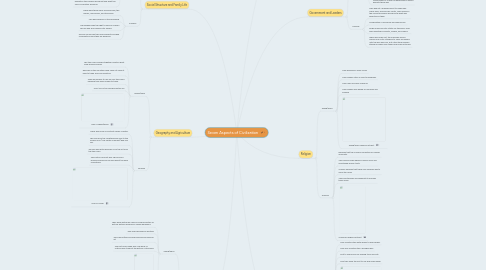
1. Geography and Agriculture
1.1. Shang/Zhou
1.1.1. The two rivers merged together create a great food producing area.
1.1.2. Because of the mountains and valleys it made it hard to trade food and livestock.
1.1.3. They would have to rely on only their food because they were unable to trade.
1.1.4. Only 10% of the land had fertile soil
1.1.5. Map of Shang/Zhou
1.2. Sumeria
1.2.1. There was never a constant supply of water
1.2.2. The land from the Mediterranean Sea to the Persian Gulf ( The Fertile Crescent) had rich soil.
1.2.3. The soil was fertile because of all the silt from the two rivers.
1.2.4. The Fertile Crescent was a good food producing area and could support the early civilizations.
1.2.5. Map of Sumer
2. Arts and Education
2.1. Shang/Zhou
2.1.1. They were writing by using a complex system of picture writing using forms called ideograms
2.1.2. They used woodblock printing
2.1.3. They did pottery and used bronze and jade for art
2.1.4. The first book made was "The Book of History"and its about the history of the Zhou
2.1.5. Art
2.2. Sumeria
2.2.1. Sumerian potters decorated pots with cedar oil paints
2.2.2. Most if not all of the students were male.
2.2.3. Schooling was associated with the priesthood and took place in temples
2.2.4. The Sumerians wrote poetically, describing events as the work of their gods, and they wrote to please their gods
2.2.5. Sumerian Pottery
3. Social Structure and Family Life
3.1. Shang/Zhou
3.1.1. The king ruled from the city of Anyang.
3.1.2. The kingdom was then divided into different sections, that were looked over by military leaders.
3.1.3. Fathers would arrange marriage for their daughters.
3.1.4. The fathers would also choose how much education the children would get and what the sons occupation would be.
3.2. Sumeria
3.2.1. There were three major social groups, the nobles, commoners, and the slaves.
3.2.2. Men held superior in the household
3.2.3. The husband had the right to divorce of even sell his wife and children into slavery
3.2.4. Women could own their own property and had a separate income than her husband.
4. Government and Leaders
4.1. Shang/Zhou
4.1.1. They ruled under a complex bureaucracy
4.1.2. Had a network of towns with only 1 king
4.1.3. Zhou had a military rule with many provinces
4.1.4. Government of Huang He depended on which dynasty there was
4.2. Sumeria
4.2.1. They had set-up government to make laws. These laws, enforced by courts, were made so the Sumerian people would know what was expected of them.
4.2.2. combination of monarchy and democracy.
4.2.3. Kings ruled each city-states for the gods. They were assisted by priests, scribes, and nobles.
4.2.4. When war broke out, the Assembly would choose one of its members to serve as leaders until the war was over, but often these leaders stayed in power even when peace had returned.
5. Religion
5.1. Shang/Zhou
5.1.1. They believed in many Gods.
5.1.2. Their religion later on lead to Buddhism
5.1.3. Their main God was Shang Di
5.1.4. Their religion was based on harmony and balance
5.1.5. Shang/Zhou religious artifact
5.2. Sumeria
5.2.1. Believed that the Universe consisted of Heaven and Earth.
5.2.2. The Sumers Gods where in human form and maintained human traits.
5.2.3. Sumers believed that there only purpose was to serve the Gods.
5.2.4. They had temples and ziggurats to worship there Gods.
5.2.5. Sumerian religious artifact
6. Science and Technology
6.1. Shang/Zhou
6.1.1. They invented the water wheel to grind grains
6.1.2. They also invented the 4 pronged hoe
6.1.3. First to use bronze for making tools and arts
6.1.4. Also they were the first to use and make paper
6.1.5. Shang/Zhou water wheel
6.2. Sumeria
6.2.1. They were credited for the making of the wheel and potters wheel.
6.2.1.1. Wheel
6.2.2. They would make boats out of animal skin.
6.2.3. Made tools such as the saws, chisels, hammers, braces, bits, nails, pins, rings, hoes, axes, knives, lancepoints, arrowheads, swords, glue, daggers, armor
6.2.4. Sumerians developed a complex system of sewers and flush toilets to rid cities of waste and unhealthy affects of swamps.
7. Economy and Trade
7.1. Shang/Zhou
7.1.1. Focused on day to day agriculture
7.1.2. Silk and rice were major exports
7.1.3. The water wheel helped them grind their grains faster
7.1.4. They invented the 4-pronged hoe
7.2. Sumeria
7.2.1. Jobs included pottery makers, stonecutters, bricklayers, metal smiths, farmers, fishers, shepherds, weavers, leather-workers, and sailors
7.2.2. Their economy was based on agriculture
7.2.3. They invented the wheel for carts, chariots, and pottery making
7.2.4. They managed to develop a system of writing known as cuneiform. It allowed them to record their lives that allowed the present to study this people from the past.
